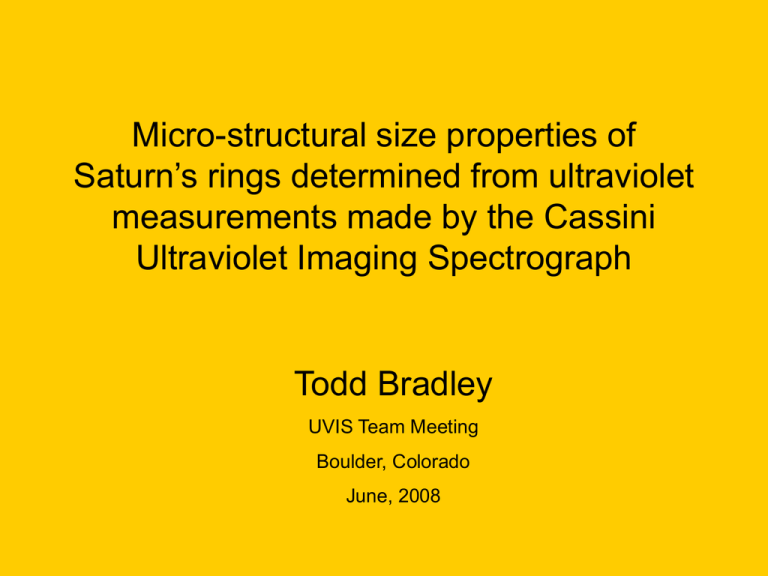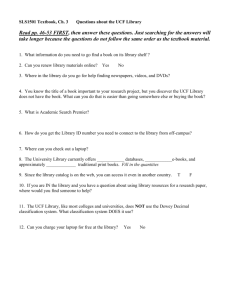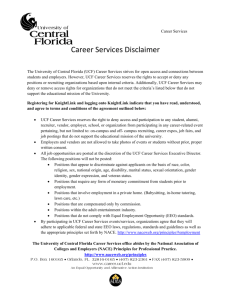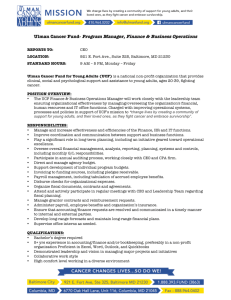Micro-structural size properties of Saturn’s rings determined from ultraviolet
advertisement

Micro-structural size properties of Saturn’s rings determined from ultraviolet measurements made by the Cassini Ultraviolet Imaging Spectrograph Todd Bradley UVIS Team Meeting Boulder, Colorado June, 2008 Investigation summary • • • • • Analyzed multiple observations in FUV Observations were all of lit side Phase angles ranged from 0.8° to 27° Computed I/F Fit I/F with Hapke model for single scattering albedo • Found variations in microstructure with radius 2 UCF 3 UCF Water ice absorption feature • Imaginary index of refraction for water ice decreases with increasing wavelength • Solar flux is mostly featureless from 150 to 175 nm • I/F = Measured radiance/solar irradiance • Absorption feature at ~ 165 nm characteristic of water ice 4 UCF Chandrasekar Classical Radiative Transfer Approach 1 1 o I 1 e o f water (1 f water ) Rc o P F 4( o ) I oK C F I/F is the bidirectional reflectance wo is the single scattering albedo P() is the phase function and o are the cosine of the incidence and emission angles, respectively is the optical depth fwater is the fraction of water ice Rc is the reflectance of a “grey” contaminant UCF 5 Hapke formulation of the scattering efficiency For short wavelengths (2pa/l >> 1), Hapke (1992) models the single scattering albedo in this way o Qs Se 1 Se 1 S i 1 Si Se = Fresnel reflection coefficient for externally incident light Si = Fresnel reflection coefficient for internally incident light Both Se and Si are computed from the complex index of refraction is the internal transmission factor and is modeled as: exp 4 pk l L where <L> is the mean path length 6 UCF Mean path length • <L>is a measure of the distance light travels after an encounter with a ring particle • <L> is affected by: – the microscopic size of water ice grains on the much larger ring particles – distance between cracks or other scattering surfaces – mean spacing between contaminants in a water-ice matrix 7 UCF Data processing and analysis Outer A ring • Bin pixels azimuthally in 4000 km radial bins • Using Hapke model along with bidirectional reflectance data, scale the magnitude of the model to the data • Fit model to extract <L> Rayleighs Cassini division Inner B ring Inner C ring Saturn Observation: UVIS_036RI_SUBML17LP001_CIRS 8 UCF Least squares extraction of <L> • Compute D =1/Nl*∑(model – I/F)2 over a range of path lengths • Minimum D = <L> • Width of curve denotes uncertainty 9 UCF Retrieval technique is independent of I/F magnitude (7.125 microns) 2X + .03 2X + .03 10 UCF Use extracted <L> in model Center = 7.125 microns • Plot of model using < L > from minimum squared difference (blue) • Red curves are model results for additional path lengths in 1 micron increments • For a single spectra, can only distinguish to within 2 – 3 microns from center • Compare multiple observations 11 UCF Multiple observations Inner C ring Inner B ring Cassini Division Outer A ring Mean ~ 7 to 27 • Decrease uncertainty by considering multiple observations • Clearly observations are repeatable with some exceptions Mean ~ 0.85 to 0.84 UCF 12 Phase angle () dependence • Observations within the B ring • As increases, the photon has to scatter more times within an ice grain in order to escape 13 UCF dependence for different radial distances 14 UCF Heuristic model interpretation of interaction of photon with ice grain Ice grains Could be contaminants, cracks, etc. UCF • For low observations, the photon has probably had few scatterings • For high , the photon probably had to scatter multiple times • For high , photon travels more within ice leading to more absorption (shifts absorption edge to 15 longer wavelengths) I/F displacement • Observations from the same location in the A ring • Larger shifts absorption edge to longer wavelengths 16 UCF Average of larger observations Inner C ring Inner B ring Cassini Division Outer A ring • <L> as a function of radius for all 6 high observations averaged • Average I/F for same 6 observations does not seem correlated with < L > 17 UCF Summary <L> microns planet 79,400 km 135,400 km For > 7 UCF • UVIS offers unique ability to see microphysical variations • Comparing multiple observations gives more confidence in the results • Present model does not relate to < L > • If simple heuristic model is correct, then low deals more with single scattering 18 Future/ongoing work • Need to incorporate more low and high > 50°) observations • If the explanation for phase angle effects is multiple scattering from contaminants, then need to start thinking about fraction of contaminant • Need to use a model that accounts for phase angle effects/multiple scattering in the path length in order to constrain ice grain size 19 UCF






